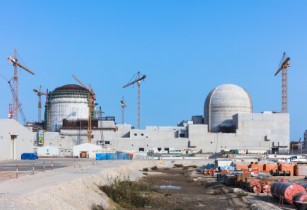By 2030, MENA is expected to have added 15.8 GW of nuclear capacity, a quantum leap from the current one gigawatt, representing a step change in the region?s energy mix, according to the latest research report by Arab Petroleum Investments Corporation (APICORP)
APICORP said that the rising electricity demand has prompted several MENA states to turn towards nuclear power to diversify their sources of energy and reduce their carbon footprint.
For countries in the GCC, nuclear power can free up more oil and gas for exports, while net-importing countries like Egypt and Jordan will be able to diversify their energy sources, enhance energy security and reduce their expensive import bills.
At present, 2.4 GW of nuclear power facilities in MENA are complete - of which only one gigawatt is operational, 5.4GW are under construction and a further eight gigawatt are planned by 2030.
However, MENA nuclear sector is facing challenges over the years. According to APICORP, the region is not fully equipped with the right knowledge and expertise to undertake full operation of nuclear plants - signified by delays in commissioning the Barakah nuclear plant in the UAE.
?Dependence on Russia to develop and, in certain instances to support the financing of nuclear projects in MENA countries, leaves the region exposed to a single supplier. Huge capital costs are leading the likes of Jordan and Saudi Arabia to consider small-scale alternatives that are more costly to build per kilowatt of electricity (KWe). Meanwhile renewed sanctions on Iran will overall slow the momentum on nuclear energy deployment within MENA,? said APICORP.
While nuclear is often seen as a source of long-term supply, this is contingent on the ability to secure large stocks of uranium. Currently, only four countries in MENA have proven uranium reserves. But, at an average global price of US$68 per kilogram this year, production in the region remains uneconomical. Therefore, countries considering nuclear will have to rely on uranium supplies coming largely from outside the region.
UAE caution leading GCC diversification
As the only GCC state with nuclear plants under construction, the UAE nuclear programme has been dubbed a model for nuclear newcomers. The International Atomic Energy Agency (IAEA) provided the UAE with detailed guidance for developing the infrastructure needed for a nuclear power programme. The Emirates Nuclear Energy Corporation (ENEC) was set up to implement the UAE nuclear energy programme. Abu Dhabi agreed to forgo domestic enrichment, and will instead source its nuclear fuel from South Korea as well as companies from France, Russia and the US. It is also examining different scenarios for dealing with the nuclear waste, including developing its own storage sites or sending waste abroad for processing and bringing back small volumes to the UAE.
Saudi Arabia adopting pragmatic approach
Economic growth, rising populations and sustained periods of low energy prices propelled high power demand growth in Saudi Arabia. The King Abdullah City for Atomic and Renewable Energy Care (KACARE) was established in 2010 to develop renewable and nuclear energy for the country. The kingdom?s initial nuclear plan aimed to produce 18 GW of power by 2032, but the announcement of the Saudi 2030 Vision revised down these plans. Increases in energy prices at the start of 2018 drove residential electricity prices up by 250 per cent, which according to APICORP, will slow annual demand growth to between 1.5-two per cent over the next five years.
?Saudi Arabia plans to award a contract for the construction of its first 2.8 GW nuclear facility by the end of 2018, though delays cannot be ruled out. KACARE has announced Russia?s Rosatom, France?s EDF, China?s CNNC, Korea?s Kepco and the US firm Westinghouse amongst those expected to carry out engineering, procurement and construction work on two nuclear reactors,? said APICORP.
Iran hopeful despite looming sanctions
Iran remains the only country in the Middle East to have a nuclear plant connected to the national grid. Commissioned in 2011, the Bushehr 1 plant reached total capacity of one gigawatt by August 2012 ? about 20 years after the initial agreement between Tehran and Moscow was signed. But this still represents only one per cent of Iran?s total power generation capacity.
Huge capital costs creating much uncertainty
Nuclear plants are very capital intensive, and with the cost of solar energy already lower than nuclear and continuing to go down, prospects for further SMR remain bleak, said APICORP.
Challenges cloud outlook
Rising domestic demand in the MENA region and pressure to fall into line with global standards to tackle climate change could boost nuclear development. But financial, technical and political problems have begun to surface, causing delays. Despite recovering oil prices, countries looking to incorporate nuclear within the energy mix will continue to face challenges.
?Governments considering developing nuclear power must budget for high initial investment costs, potential delays and cost overruns. At a time when governments are rationalising spending, nuclear will trail behind conventional and renewable sources for the near future. Low credit ratings also make it difficult for some MENA governments to access cheap finance. This will mean that countries will look to smaller scale reactors that cannot meet the capacity needs in line with rising electricity demand,? noted APICORP.





